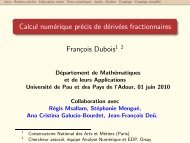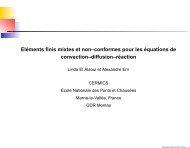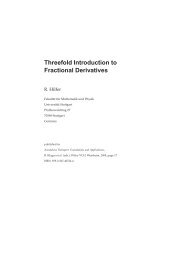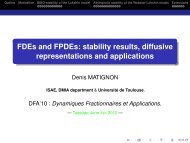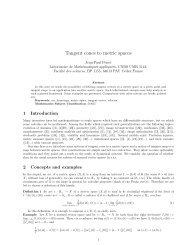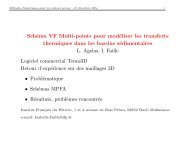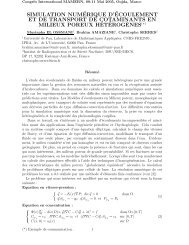A Stochastic Model of Crystallization in an Emulsion - Laboratoire de ...
A Stochastic Model of Crystallization in an Emulsion - Laboratoire de ...
A Stochastic Model of Crystallization in an Emulsion - Laboratoire de ...
You also want an ePaper? Increase the reach of your titles
YUMPU automatically turns print PDFs into web optimized ePapers that Google loves.
phase dur<strong>in</strong>g the experimentation. We thus consi<strong>de</strong>r <strong>an</strong> emulsion conta<strong>in</strong><strong>in</strong>g the phase-ch<strong>an</strong>ge<br />
material. However, repeat<strong>in</strong>g the melt<strong>in</strong>g-freez<strong>in</strong>g cycles, <strong>de</strong>stroys the dispersed structure <strong>of</strong> the<br />
emulsion. To avoid that, a surface-active agent (surfact<strong>an</strong>t) c<strong>an</strong> be used <strong>an</strong>d so the behavior <strong>of</strong><br />
the emulsion is closed to the behavior <strong>of</strong> solid matter. Therefore, the effect <strong>of</strong> free-convection c<strong>an</strong><br />
be ignored.<br />
The object <strong>of</strong> this paper is to talk about the crystallization <strong>of</strong> <strong>an</strong> emulsion.<br />
This process is based on two phenomena (cf. Dumas et al [6]) :<br />
1) the un<strong>de</strong>rcool<strong>in</strong>g, <strong>de</strong>ned as the difference between the melt<strong>in</strong>g temperature TF<br />
<strong>an</strong>d the<br />
crystallization temperature, <strong>in</strong>creases as the sample size <strong>of</strong> PCM <strong>de</strong>creases. For example, for water,<br />
3 <br />
3<br />
the un<strong>de</strong>rcool<strong>in</strong>g is 14 K for a few cm macrosamples <strong>an</strong>d is 38 K for a few m microsamples.<br />
Moreover, <strong>an</strong>y droplet which temperature is less th<strong>an</strong> TF<br />
may crystallize as soon as <strong>an</strong>y perturbation<br />
or shock occurs. Where from the second phenomenon :<br />
2) the ma<strong>in</strong> feature <strong>of</strong> emulsions crystallization <strong>in</strong> <strong>an</strong> <strong>in</strong>stable dispersed medium (here <strong>an</strong><br />
emulsion with temperature less th<strong>an</strong> TF<br />
) is its stochastic behavior. Samples <strong>of</strong> PCM which<br />
are apparently i<strong>de</strong>ntical, will not tr<strong>an</strong>sform at the same temperature dur<strong>in</strong>g the cool<strong>in</strong>g process.<br />
This leads to the notion <strong>of</strong> nucleation rate. The Nucleation Theorie gives us a function J,<br />
the<br />
<strong>de</strong>term<strong>in</strong>istic part <strong>of</strong> the crystallization speed, per unit <strong>of</strong> time. In the sequel, we consi<strong>de</strong>r the<br />
nucleation rate as a stochastic perturbation <strong>of</strong> this speed J.<br />
We assume that J is a positive lipschitz function <strong>of</strong> the temperature with, J(0) = 0 <strong>an</strong>d J( x)<br />
=<br />
0 , ∀x ∈ [ T , + ∞[<br />
.<br />
∞<br />
F<br />
One mays nd a presentation <strong>of</strong> the experimental context <strong>in</strong> the last section.<br />
Let us <strong>de</strong>note by u the temperature <strong>of</strong> the emulsion <strong>an</strong>d ϕ( t, x)<br />
the proportion <strong>of</strong> crystallized<br />
droplets, <strong>in</strong> the neighborhood <strong>of</strong> a po<strong>in</strong>t x <strong>an</strong>d a time t .<br />
Then, the mathematical mo<strong>de</strong>ll<strong>in</strong>g proposed by Dumas et al [6] is based on :<br />
the nonl<strong>in</strong>ear heat equation with a heat source term proportional to the speed <strong>of</strong> crystallization,<br />
i.e.<br />
∂u<br />
∂ϕ<br />
( u)<br />
= ,<br />
∂t<br />
∂t<br />
with some Fouriers type boundary conditions<br />
<strong>in</strong> <br />
(1)<br />
∂ u<br />
<br />
∂<br />
N<br />
( ) ∞<br />
= ( u u ) , on = ∂<br />
where u is a given temperature on the boundary ,<br />
the follow<strong>in</strong>g stochastic differential equation for the speed <strong>of</strong> crystallization<br />
∂ϕ<br />
∂t<br />
= (1 ϕ) J( u) + b( u, ϕ) <br />
∂w<br />
, <strong>in</strong><br />
∂t<br />
where 1 ϕ is the proportion <strong>of</strong> uncrystallized droplets, J( u) the nucleation rate, w the st<strong>an</strong>dard<br />
real Wiener process <strong>an</strong>d b the r<strong>an</strong>dom part <strong>of</strong> the nucleation phenomenon.<br />
A rigorous formulation <strong>of</strong> our system will be given below.<br />
2 Notations <strong>an</strong>d hypothesis<br />
From now on, we consi<strong>de</strong>r the follow<strong>in</strong>g notations :<br />
is a boun<strong>de</strong>d doma<strong>in</strong> <strong>of</strong> R with a smooth boundary <strong>an</strong>d <strong>an</strong> outward unit normal ,<br />
for T > 0 , Q is the cyl<strong>in</strong><strong>de</strong>r ]0 , T [ <strong>an</strong>d its lateral boundary ]0 , T [ ,<br />
2<br />
(2)<br />
(3)



